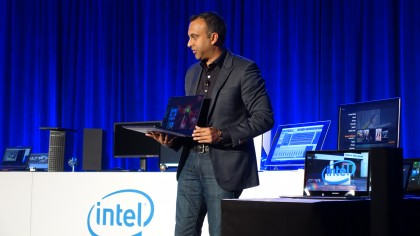Skylake tablets with Intel Core M will be twice as fast as today's slates
And with even battery life

Intel's current Core M processor is an energy efficient chip that brought enough processing power to current laptops and tablets like Apple's MacBook, Dell's Venue 11 Pro 7000 Series and Lenovo's Yoga Pro 3. However, one of the complaints with the M architecture is that for heavy processing tasks, these systems can feel slow, but the tradeoff is that you get better battery life in a thin, fanless design.
With the second generation of Core M processor, Intel promises significantly better performance. Thanks to Skylake's underlying platform, the new Core M systems, which will start shipping in laptops and tablets, can achieve twice the processing performance of today's leading tablets, said Navin Shenoy, Corporate Vice President and General Manager of Intel's Mobility Client Platform, in a meeting ahead of Skylake's unveil at IFA 2015.
Processing power isn't the only thing that gets revamped. Shenoy says that the new Core M comes with "40% gen-on-gen graphics improvements," meaning that graphic performance will be 40% better with Skylake than the current crop of Core M devices.
Yet, despite a huge boost in performance, Intel is still committed to delivering all-day battery life with Skylake's Core M, increasing battery life by an hour. Whereas the current Core M chips can deliver up to nine hours of battery life, Skylake's Core M processors can do 10 hours of computing on a single charge. Core M also supports USB-C so you can use one connector for peripherals, display and charging.
The new Core M family
With the new M, Intel is segmenting the chip based on performance. The Intel Core M3 will be the base model, and Intel will also offer a Core M5 and Core M7 processor, with the M7 SKU offered on high performance, premium fanless tablets and notebooks.
The new Skylake Core M processors will support Intel vPro technology for enterprise use.
When asked if performance differences between various Core M Ultrabooks on the market today forced Intel to create separate models in the lineup, Kirk Skaugen, Senior VP and General Manager of Intel's Client Computing Group, responded only by saying that the company was able to create enough distinction between the M3, M5 and M7 processors to give the chips their own identity, similar to what Intel has done for the Core i3, i5 and i7 processors.
Sign up to the TechRadar Pro newsletter to get all the top news, opinion, features and guidance your business needs to succeed!
Impressive graphics
Because Core M systems use a fanless design, improving graphics performance was an important decision for Intel as these machines cannot accommodate discrete GPUs.
In highlighting some of the graphics power of Core M, Skaugen and his team showed that Core M can drive up to three displays at 4K UHD resolution playing videos at 60 frames per seecond using the integrated Intel HD 500 graphics.
Focus on 2-in-1s
Intel is honing its focus on 2-in-1 convertible owners with its Core M processor design. In a study, Intel found that half of 2-in-1 owners had considered a tablet, but ultimately went with a 2-in-1 design for its versatility and productivity. Additionally, these buyers will refresh their hardware faster than traditional tablet owners.

The market is also headed in this direction, Shenoy hinted as he flashed a few prototype 2-in-1 designs in a meeting ahead of IFA 2015. In 2013, there were only 25 2-in-1 devices, retailing for an average of $900.
Today, there are over 80 devices on the market utilizing this versatile form factor, and prices have dropped. The average price for a two-in-one is now $650. The diversity of devices and affordability have spurred growth in adoption in this form factor, with a quadrupling of volume of devices shipped.
Additionally, we're also hearing rumors that Apple will adopt the new Core M3 and Core M5 processors in its next MacBook release.
- Read our analysis of the Core M architecture